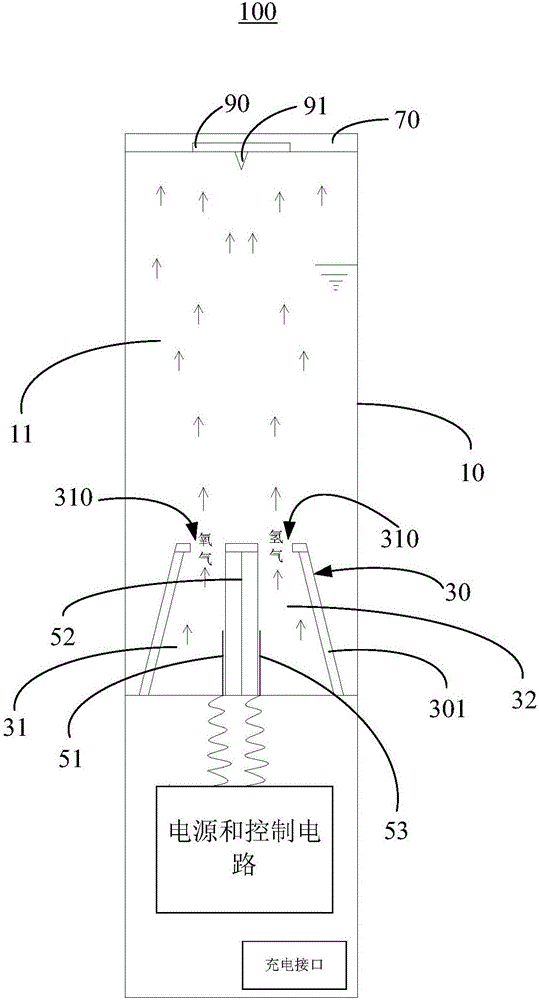Water electrolysis cup
A water cup and electrolysis device technology, applied in the field of water treatment, can solve the problems of poor hydrogen-rich water effect and the like
- Summary
- Abstract
- Description
- Claims
- Application Information
AI Technical Summary
Problems solved by technology
Method used
Image
Examples
Embodiment 1
[0051] When the anode chamber 31 is provided with a through hole 310 to communicate with the drinking water area 11; realize the separation of the ascending channels of the oxygen bubbles and hydrogen bubbles generated by the electrolysis of water;
[0052] The electrolyzed water cup 100 is provided with a negative oxygen ion generator 90, preferably, the negative oxygen ion generator 90 is arranged on the cup cover 70,
[0053] Specifically, the negative oxygen ion generator 90 includes a negative oxygen ion releasing head 91, and the negative oxygen ion releasing head 91 faces the cup body 10, and ionizes oxygen into negative oxygen ions;
[0054] By introducing the negative oxygen ion generator 90, the reaction principle in the electrolyzed water cup 100 is as follows:
[0055] 1. Tap water contains various minerals and is a weak electrolyte, which can ionize a small amount of H + (hydrogen ion) and OH - (hydroxide ion).
[0056] ①H 2 O=H + +OH - ②H + +OH - =H 2 o ...
Embodiment approach
[0071] refer to figure 1 with figure 2 , when the electrolysis device 50 is provided with a pair of electrodes, a diaphragm 52 separates the frame cover 30 to form a cathode chamber 32 and an anode chamber 31, and the tops of the cathode chamber 32 and the anode chamber 31 are opened There are through holes 310 .
[0072] refer to image 3 with Figure 4 , when the electrolysis device 50 is provided with two pairs of electrodes, the two diaphragms 52 separate the frame cover 30 to form two cathode chambers 32 and an anode chamber 31, and the anode chamber 31 is located between the cathode chambers 32, from the left To the right is the cathode chamber 32, the anode chamber 31, and the cathode chamber 32. The tops of the two cathode chambers 32 and one anode chamber 31 are provided with through holes 310 .
[0073] refer to Figure 5 with Image 6 , when the electrolysis device 50 is provided with four pairs of electrodes, the four diaphragms 52 form a square area, the a...
Embodiment 2
[0076] When the anode chamber 31 opens a through hole 310 to communicate with the outside of the cup body 10 , the separation of oxygen bubbles and hydrogen bubbles generated by electrolyzed water is realized.
[0077] It can be understood that the outside of the cup body 10 refers to the discharge of oxygen from the electrolysis reaction area, that is, the anode chamber 31 . Of course, the electrolysis water cup 100 can have another area for storing oxygen.
[0078] The technical solution of this embodiment separates the acidic water so that the electrolyzed water in the drinking water area 11 is also weakly alkaline with a negative potential.
[0079] In this embodiment, there are three implementation methods for setting the number of electrodes as follows:
[0080] refer to Figure 7 , when the electrolysis device 50 includes two pairs of electrodes, the two diaphragms 52 separate the frame cover 30 to form two cathode chambers 32 and an anode chamber 31, the anode chamber...
PUM
 Login to View More
Login to View More Abstract
Description
Claims
Application Information
 Login to View More
Login to View More - R&D
- Intellectual Property
- Life Sciences
- Materials
- Tech Scout
- Unparalleled Data Quality
- Higher Quality Content
- 60% Fewer Hallucinations
Browse by: Latest US Patents, China's latest patents, Technical Efficacy Thesaurus, Application Domain, Technology Topic, Popular Technical Reports.
© 2025 PatSnap. All rights reserved.Legal|Privacy policy|Modern Slavery Act Transparency Statement|Sitemap|About US| Contact US: help@patsnap.com



